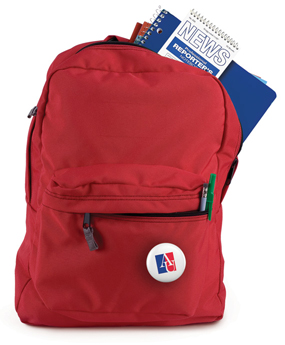
The Keystone State became a key battleground in 2022, with Republican Mehmet Oz and Democrat John Fetterman facing off in a high-profile—and highly consequential US Senate race. Twenty-four AU political science and journalism students covered the action from Philadelphia in November as part of a signature experiential learning class, now in its 15th year.
Cotaught by SOC professor Lynne Perri, SOC executive in residence Molly O'Rourke, and Betsy Fischer Martin, SPA/BA ’92, SOC/MA ’96, executive director of SPA’s Women and Politics Institute, the course—which has also taken students to New Hampshire, South Carolina, and Virginia—teaches them how to interview voters and interpret poll data. They also explored the political, historical, and social landscape of Pennsylvania—always among the most competitive states during election season.
“You can only learn so much from watching events on C-SPAN or [campaign] ads,” says Martin, who won three Emmys during her 22 years at NBC News, covering four presidential elections. “Alums who are now successful journalists credit the class with shaping their professional interests.”
Over the course of five days, students—who also covered the gubernatorial race between Democrat Josh Shapiro and Republican Doug Mastriano—interviewed Oz at the polls, huddled for 10 minutes with a Mastriano senior advisor, and attended a Fetterman rally. “Coming off of what everybody acknowledged was a shaky debate performance, seeing [Fetterman] in person provided the students with a different lens,” O’Rourke says.
On Election Day, students fanned out in groups of five across the birthplace of independence, arriving at polls across the Philadelphia area by 6 a.m. to ask voters’ thoughts on the candidates and the issues.
“The political students say: ‘I’ve interviewed people, but not like this—not where I have to be so intrusive and get their name, age, and occupation on the record,’” says Perri, who cofounded the course in 2008 with the late SPA professor and pollster Dotty Lynch. But the journalism and political science students worked together, with the latter offering important context that informed the reporting.
“Going up to people and interviewing them on the street is something that I do all the time,” says journalism major Gabriel Castro-Root, SOC/BA ’25. “We all had different areas of expertise, so we could work together to balance each other out.”
As Election Day turned to night, students worked from a hotel conference room, subsisting on cold pizza as they tapped out real-time updates on their laptops and phones. The Eagles shaped voter insights into 100-word vignettes, dispatching them to the Philadelphia Inquirer, where reporters wove them into their coverage. Journalists are often “busy at their desks [on Election Day], looking at exit polls and trying to write their stories,” O’Rourke says. They don’t have time to spend six hours in the field talking to voters, so “they used our students’ quotes as color commentary for some of their stories.”
The work didn’t end when the races were called for Fetterman and Shapiro. After heading back to DC, students crafted their final projects for the class, which took a variety of forms: paper, photo essay, video, or podcast. Projects from previous cohorts have often turned into capstones or clips for potential employers.
O’Rourke challenges students to highlight experiences they wouldn’t have had, if not for the trip. “Don’t just cover the exit polls, because you could have sat in DC and looked at the exit polls,” O’Rourke says. “You have to mirror the exit polls with the voter interviews that you did on Election Day and explain how that all comes together.” Battleground Virginia students saw that firsthand in 2021 when, despite polls suggesting Democrat Terry McAuliffe was primed to edge out Republican Glenn Youngkin for governor, supporters of the latter had more energy and enthusiasm down the stretch.
Battleground Pennsylvania was the sixth iteration of the class, which Perri and Lynch began plotting in 2007. They originally planned to cover three states: Iowa, New Hampshire, and South Carolina. Iowa proved too difficult as a caucus and cost limited travel to New Hampshire. They’ve covered every presidential primary in New Hampshire since 2008.
In 2020, Perri, O’Rourke, and Martin finally added a South Carolina option, enabling students to explore the politics of a more diverse state. They added Virginia to the slate in 2021 so that the class was offered more than just once every four years for a presidential election.
“We were blogging in Manchester in 2008 and created a website unique to the class to do that,” Perri says. The evolution of cell phones over the last 15 years has shaped the way students report today, allowing them to ditch bulky cameras and recording equipment.
More than technology has changed since 2008, however. Perri says communities generally trust reporters from their local newspaper, but suspicion of the media as an institution has grown in recent elections. Castro-Root was asked multiple times in Philadelphia if he was part of the media, or if he was a student. “It’s something that I’ve read about and seen on TV, but I hadn’t personally experienced,” he says.
Still, Perri thinks students were well-prepared to handle heated moments. “We’ve had to learn when to put the notebooks away and just be present.”
Students have already begun using their experience in the class to leverage professional opportunities. Castro-Root, talked about it during a successful internship interview with his hometown paper, the San Francisco Chronicle, a week after returning to DC.
“The rewarding part of this class is the number of students that say this class is a highlight of their college career,” Martin says.
Battleground Pennsylvania also marked the first time that donors covered the cost of the trip, making it more accessible for students. Perri, O’Rourke, and Martin are already identifying states to cover in 2024 as the primary calendar begins to take shape.